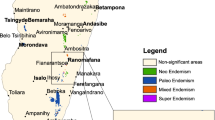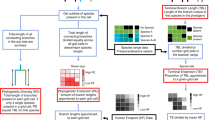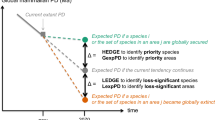Abstract
Accounting for evolutionary relationships between and within species is important for biodiversity conservation planning, but is rarely considered in practice. Here we introduce a novel framework to identify priority conservation areas accounting for phylogenetic and intraspecific diversity, integrating concepts from phylogeny, phylogeography, spatial statistics and spatial conservation prioritization. The framework allows planners to incorporate and combine different levels of evolutionary diversity and can be applied to any taxonomic group and to any region in the world. We illustrate our approach using amphibian and reptile species occurring in a biodiversity hotspot region, the Iberian Peninsula. We found that explicitly incorporating phylogenetic and intraspecific diversity in systematic conservation planning provides advantages in terms of maximizing overall biodiversity representation while enhancing its persistence and evolutionary potential. Our results emphasize the need to account for the evolutionary continuum in order to efficiently implement biodiversity conservation planning decisions.
This is a preview of subscription content, access via your institution
Access options
Access Nature and 54 other Nature Portfolio journals
Get Nature+, our best-value online-access subscription
$29.99 / 30 days
cancel any time
Subscribe to this journal
Receive 12 digital issues and online access to articles
$119.00 per year
only $9.92 per issue
Buy this article
- Purchase on Springer Link
- Instant access to full article PDF
Prices may be subject to local taxes which are calculated during checkout




Similar content being viewed by others
References
Watson, J. E. M., Dudley, N., Segan, D. B. & Hockings, M. The performance and potential of protected areas. Nature 515, 67–73 (2014).
Myers, N., Mittermeler, R. A., Mittermeler, C. G., da Fonseca, G. A. B. & Kent, J. Biodiversity hotspots for conservation priorities. Nature 403, 853–858 (2000).
Eken, G. et al. Key biodiversity areas as site conservation targets. Bioscience 54, 1110–1118 (2004).
Margules, C. & Sarkar, S. Systematic Conservation Planning (Cambridge Univ. Press, 2007).
Moilanen, A ., Possingham, H. P. & Wilson, K. A. in Spatial Conservation Prioritization—Quantitative Methods and Computational Tools (eds Moilanen, A., Wilson, K. A. & Possingham, H. P. ) (Oxford Univ. Press, 2009).
Faith, D. P. Conservation evaluation and phylogenetic diversity. Biol. Conserv. 61, 1–10 (1992).
Crandall, K. A., Bininda-Emonds, O. R. P., Mace, G. M. & Wayne, R. K. Considering evolutionary processes in conservation biology. Trends Ecol. Evol. 15, 290–295 (2000).
Moritz, C. Strategies to protect biological diversity and the evolutionary processes that sustain it. Syst. Biol. 51, 238–254 (2002).
Vane-Wright, R. I., Humphries, C. J. & Williams, P. H. What to protect? Systematics and the agony of choice. Biol. Conserv. 2, 235–254 (1991).
Srivastava, D. S., Cadotte, M. W., MacDonald, A. A. M., Marushia, R. G. & Mirotchnick, N. Phylogenetic diversity and the functioning of ecosystems. Ecol. Lett. 15, 637–648 (2012).
Pollock, L. J. et al. Phylogenetic diversity meets conservation policy: small areas are key to preserving eucalypt lineages. Phil. Trans. R. Soc. Lond. B Biol. Sci. 370, 20140007 (2015).
Asmyhr, M. G., Linke, S., Hose, G. & Nipperess, D. A. Systematic conservation planning for groundwater ecosystems using phylogenetic diversity. PLoS ONE 9, e115132 (2014).
Forest, F. et al. Preserving the evolutionary potential of floras in biodiversity hotspots. Nature 445, 757–760 (2007).
Veron, S., Davies, T. J., Cadotte, M. W., Clergeau, P. & Pavoine, S. Predicting loss of evolutionary history: where are we? Biol. Rev. 92, 271–291 (2015).
Diniz-Filho, J. A. F., Loyola, R. D., Raia, P., Mooers, A. O. & Bini, L. M. Darwinian shortfalls in biodiversity conservation. Trends Ecol. Evol. 28, 689–695 (2013).
Rodrigues, A. S. L ., Brooks, T. M. & Gaston, K. J. in Phylogeny and Conservation (eds Purvis, A., Gittleman, J. & Brooks, T. ) 101–119 (Cambridge Univ. Press, 2005).
Devictor, V. et al. Spatial mismatch and congruence between taxonomic, phylogenetic and functional diversity: the need for integrative conservation strategies in a changing world. Ecol. Lett. 13, 1030–1040 (2010).
Tucker, C. M. & Cadotte, M. W. Unifying measures of biodiversity: understanding when richness and phylogenetic diversity should be congruent. Divers. Distrib. 19, 845–854 (2013).
Morlon, H. et al. Spatial patterns of phylogenetic diversity. Ecol. Lett. 14, 141–149 (2011).
Reed, D. H. & Frankham, R. Correlation between fitness and genetic diversity. Conserv. Biol. 17, 230–237 (2003).
Frankham, R. & Ralls, K. Inbreeding leads to extinction. Nature 392, 441–442 (1998).
Sgro, C. M., Lowe, A. J. & Hoffmann, A. A. Building evolutionary resilience for conserving biodiversity under climate change. Evol. Appl. 4, 326–337 (2011).
Tarroso, P., Velo-Antón, G. & Carvalho, S. B. phylin: an r package for phylogeographic interpolation. Mol. Ecol. Resour 15, 349–357 (2015).
Rosauer, D. F., Catullo, R. A., VanDerWal, J., Moussalli, A. & Moritz, C. Lineage range estimation method reveals fine-scale endemism linked to Pleistocene stability in Australian rainforest herpetofauna. PLoS ONE 10, e0126274 (2015).
Funk, W. C., McKay, J. K., Hohenlohe, P. A. & Allendorf, F. W. Harnessing genomics for delineating conservation units. Trends Ecol. Evol. 27, 489–496 (2012).
Hewitt, G. M. Some genetic consequences of ice ages, and their role in divergence and speciation. Biol. J. Linn. Soc. 58, 247–276 (1996).
Carnaval, A. C. et al. Prediction of phylogeographic endemism in an environmentally complex biome. Proc. R. Soc. Lond. B Biol. Sci. 281, 20141461 (2014).
Thomassen, H. A. et al. Mapping evolutionary process: a multi-taxa approach to conservation prioritization. Evol. Appl. 4, 397–413 (2011).
Vasconcelos, R., Brito, J. C., Carvalho, S. B., Carranza, S. & Harris, D. J. Identifying priority areas for island endemics using genetic versus specific diversity—the case of terrestrial reptiles of the Cape Verde Islands. Biol. Conserv. 153, 276–286 (2012).
Rissler, L. J., Hijmans, R. J., Graham, C. H., Moritz. C. & Wake, D. B. Phylogeographic lineages and species comparisons in conservation analyses: a case study of california herpetofauna. Am. Nat. 167, 655–666 (2006).
Pope, L. C., Liggins, L., Keyse, J., Carvalho, S. B. & Riginos, C. Not the time or the place: the missing spatio-temporal link in publicly available genetic data. Mol. Ecol. 24, 3802–3809 (2015).
Brooks, T. M. et al. Why and how might genetic and phylogenetic diversity be reflected in the identification of key biodiversity areas? Phil. Trans. R. Soc. Lond. B Biol. Sci. 370, 3802–3809 (2015).
Rosauer, D., Laffan, S. W., Crisp, M. D., Donnellan, S. C. & Cook, L. G. Phylogenetic endemism: a new approach for identifying geographical concentrations of evolutionary history. Mol. Ecol. 18, 406–407 (2009).
Isaac, N. J. B., Turvey, S. T., Collen, B., Waterman, C. & Baillie, J. E. M. Mammals on the EDGE: conservation priorities based on threat and phylogeny. PLoS ONE 2, e296 (2007).
Bennett, J. R. et al. Balancing phylogenetic diversity and species numbers in conversation prioritization, using a case study of threatened species in New Zealand. Biol. Conserv. 174, 47–54 (2014).
Gómez, A. & Lunt, D. H. in Phylogeography of Southern European Refugia (eds Weiss, S. & Ferrand, N. ) 155–188 (Springer, 2006).
Strecker, A. L., Olden, J. D., Whittier, J. B. & Paukert, C. P. Defining conservation priorities for freshwater fishes according to taxonomic, functional, and phylogenetic diversity. Ecol. Appl. 21, 3002–3013 (2011).
Rodrigues, A. S. L. et al. Complete, accurate, mammalian phylogenies aid conservation planning, but not much. Phil. Trans. R. Soc. Lond. B Biol. Sci. 366, 2652–2660 (2011).
Ponce-Reyes, R., Clegg, S. M., Carvalho, S. B., McDonald-Madden, E. & Possingham, H. P. Geographic surrogates of genetic variation for selecting island populations for conservation. Divers. Distrib. 20, 640–651 (2014).
Vernesi, C. et al. Where's the conservation in conservation genetics? Conserv. Biol. 22, 802–804 (2008).
Mace, G. M. & Purvis, A. Evolutionary biology and practical conservation: bridging a widening gap. Mol. Ecol. 17, 9–19 (2008).
Beger, M. et al. Evolving coral reef conservation with genetic information. Bull. Mar. Sci. 90, 159–185 (2014).
Angeloni, F., Wagemaker, N., Vergeer, P. & Ouborg, J. Genomic toolboxes for conservation biologists. Evol. Appl. 5, 130–143 (2012).
Fitzpatrick, M. C. & Keller, S. R. Ecological genomics meets community-level modelling of biodiversity: mapping the genomic landscape of current and future environmental adaptation. Ecol. Lett. 18, 1–16 (2015).
Loureiro, A., Ferrand de Almeida, N., Carretero, M. A. & Paulo, O. S. Atlas dos Anfíbios e Répteis de Portugal (Instituto da Conservação da Natureza e da Biodiversidade, 2008).
Pleguezuelos, J. M ., Márquez, R. & Lizana, M. Atlas y Libro Rojo de los Anfíbios y Reptiles de España (Dirección General de Conservación de la Naturaleza, Asociación Herpetologica Española, 2002).
Drummond, A. J., Suchard, M. A., Xie, D. & Rambaut, A. Bayesian Phylogenetics with BEAUti and the BEAST 1.7. Mol. Biol. Evol. 29, 1969–1973 (2012).
Kembel, S. W. et al. Picante: R tools for integrating phylogenies and ecology. Bioinformatics 26, 1463–1464 (2010).
R Development Core Team R: A Language and Environment for Statistical Computing (R Foundation for Statistical Computing, 2014).
Zhang, J., Pei, N. & Mi, X. phylotools: phylogenetic tools for eco-phylogenetics (2015); https://cran.r-project.org/web/packages/phylotools/index.html
Reid, N. M. & Carstens, B. C. Phylogenetic estimation error can decrease the accuracy of species delimitation: a Bayesian implementation of the general mixed Yule-coalescent model. BMC Evol. Biol. 12, 196 (2012).
Moilanen, A. et al. Zonation—spatial conservation planning methods and software. Version 4. User Manual. 290 (C-BIG Conservation Biology Informatics Group, Univ. Helsinki, 2014).
Rodrigues, A. S. L. & Gaston, K. J. Maximising phylogenetic diversity in the selection of networks of conservation areas. Biol. Conserv. 105, 103–111 (2002).
Moilanen, A. et al. Prioritizing multiple-use landscapes for conservation: methods for large multi-species planning problems. Proc. R. Soc. Lond. B Biol. Sci. 272, 1885–1891 (2005).
Ball, I. R., Possingham, H. P. & Watts, M. E. in Spatial Conservation Prioritization - Quantitative Methods and Computational Tools (eds Moilanen, A., Wilson, K. A. & Possingham, H. P. ) 185–195 (Oxford Univ. Press, 2009).
Acknowledgements
This work was developed under the project PTDC/BIABIC/118624/2010, funded by Fundação para a Ciência e Tecnologia (FCT) through the North of Portugal Regional Operational Programme 2007/2013 (ON.2O Novo Norte), the National Strategic Reference Framework (NSRF), and the European Regional Development Fund (ERDF); and through project PTDC/BIA-BIC/3545/2014, supported by Norte Portugal Regional Operational Programme (NORTE 2020), under the PORTUGAL 2020 Partnership Agreement, through the European Regional Development Fund (ERDF). P.T. and S.B.C. were funded by FCT postdoctoral grants (SFRH/BPD/93473/2013 and SFRH/BPD/74423/2010, respectively) and G.V.-A. was supported by an IF contract (IF/01425/2014), attributed by FCT. S.C. was funded by project CGL2015-70390-P (MINECO/FEDER). H.P.P. was supported by the Australian Research Council. We thank all the colleagues who kindly provided samples and molecular data: A. Perera, A. Miraldo, A. Kaliontzopoulou, B. Carvalho, C. Rato, D. Guicking, F. F. Martínez, H. Gonçalves, I. Martínez-Solano, J. Harris, M. Fonseca, M. Carretero, N. Sillero, R. Godinho, R. Cunha, U. Fritz and X. Santos.
Author information
Authors and Affiliations
Contributions
S.B.C., S.C., C.M. and H.P.P. designed the study. S.B.C., P.T. and A.P.P. compiled the data. M.B., G.V.-A. and S.C. collected field samples. M.B. carried out the laboratory work. G.V.A. and S.C. performed the molecular analysis. P.T. and S.B.C. performed the lineage’s occurrence analysis. S.B.C. and A.P.P. performed the spatial prioritization analysis. S.B.C. led the writing, to which all authors contributed.
Corresponding author
Ethics declarations
Competing interests
The authors declare no competing financial interests.
Supplementary information
Supplementary Information
Details on study area; Supplementary Methods; Supplementary References; Supplementary Tables 1–6; Supplementary phylogenetic trees. (PDF 2509 kb)
Rights and permissions
About this article
Cite this article
Carvalho, S., Velo-Antón, G., Tarroso, P. et al. Spatial conservation prioritization of biodiversity spanning the evolutionary continuum. Nat Ecol Evol 1, 0151 (2017). https://doi.org/10.1038/s41559-017-0151
Received:
Accepted:
Published:
DOI: https://doi.org/10.1038/s41559-017-0151
This article is cited by
-
Before it’s too late: priority areas for conservation of cryptic and threatened species of troglobitic arthropods in the Brazilian semiarid
Biodiversity and Conservation (2024)
-
A conservation planning strategy applied to the evolutionary history of the mantellid frogs of Madagascar
npj Biodiversity (2023)
-
Spatial prioritization for the conservation of terrestrial vertebrate genera in the Neotropics
Biodiversity and Conservation (2023)
-
Improving biodiversity protection through artificial intelligence
Nature Sustainability (2022)
-
Amphibian phylogenetic diversity in the face of future climate change: not so good news for the chilean biodiversity hotspot
Biodiversity and Conservation (2022)



